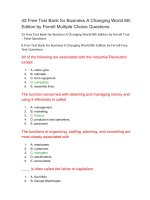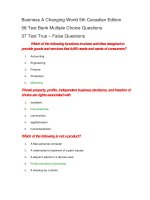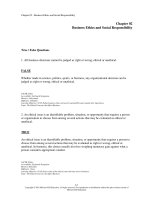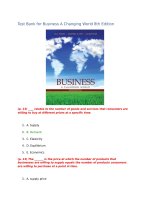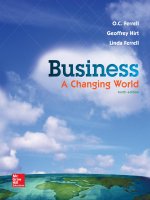Lecture Business: A changing world - Chapter 15: Money and the financial system
Bạn đang xem bản rút gọn của tài liệu. Xem và tải ngay bản đầy đủ của tài liệu tại đây (434.14 KB, 25 trang )
Chapter Fifteen
Money and
the Financial System
© 2003 McGrawHill Ryerson Limited
The Three Functions
of Money
15-1
Medium of
Accepted as payment for
Exchange
products and resources
Unit of
Single standard for assigning
measurement and comparing values of
products and resources
Store of
value
Means of retaining and
accumulating wealth
© 2003 McGrawHill Ryerson Limited
The Six Characteristics
of Money
15-2
•
•
•
•
•
•
Acceptability
Divisibility
Portability
Stability
Durability
Difficulty to counterfeit
© 2003 McGrawHill Ryerson Limited
Penny Pinchers
15-3
1829
3044
4564
65over
46%
A penny saved is…
Those who always
take pennies
in change
40%
56%
71%
While 67% of adults say the government should continue making
pennies, 51% sometimes leave theirs at the store.
© 2003 McGrawHill Ryerson Limited
Source: />news/nsnap062.htm
Near Money
15-5
•
•
•
•
•
•
•
•
Savings account
Money market account
Guaranteed investment certificates
Credit card
Debit card
Traveler’s cheque
Money order
Cashier’s cheque
© 2003 McGrawHill Ryerson Limited
Credit Card Bill Paying
All
Households
15-6
With Income of
$50,000
$100,000
Pay all each month
44%
40%
Never pay off
36%
45%
Pay some monthly
21%
15%
© 2003 McGrawHill Ryerson Limited
Source: “A New Financial Health Barometer,”
Business Week, November 30, 1998, p. 8.
Credit Cards Marketed on
the Internet
15-7
• More than 15 million people searched the Internet
for a new credit card within the last three years.
• Nearly 6 million people completed online card
applications within the last two years.
• NextCard markets its credit card solely on the
Web and receives between 80,000 and 100,000
applications per month
© 2003 McGrawHill Ryerson Limited
Source: Tom Maguire, “Click Here and Charge,”
American Demographics, January 1999.
The Bank of Canada
15-8
• Founded in 1934 to regulate “ credit policy and
currency in the best interests of the economic life of
the nation.
• Became a crown corporation in 1938 with all
shares now held by the Minister of Finance.
© 2003 McGrawHill Ryerson Limited
The Responsibilities of the
the Bank of Canada
15-9
• To control the money supply using monetary
policy
• To provide central banking services
• To be the sole issuer of currency
• To administer the public debt
• To oversee the administration of the clearing and
settlement systems
© 2003 McGrawHill Ryerson Limited
The Tools of Monetary Policy
15-10
1. Open market operations
2. Influence on the overnight rate
3. Cash management activities
© 2003 McGrawHill Ryerson Limited
Central Banking Services
15-11a
1.
2.
3.
4.
5.
Oneday sale and repurchase transactions
Acting as the federal government’s banker
Intervention in the foreign exchange market as agent of
the Minister of Finance
Management of the governments foreign exchange
reserves
Maintenance of deposit and safekeeping accounts for
Canadian financial institutions and other central banks
© 2003 McGrawHill Ryerson Limited
The Issuance of Currency
15-11b
The Bank of Canada is:
• The sole issuer of Canadian bank notes
• Is responsible for ensuring the authenticity of all bank
notes
• Operates to ensure a sufficient supply of currency in the
economy
© 2003 McGrawHill Ryerson Limited
Administration of the Public
Debt
15-11c
The Bank of Canada:
• Advises the federal government on borrowing
• Manages new debt offerings
• Services outstanding debt
• Administers some 7 million Canada Savings Bond
holder accounts
© 2003 McGrawHill Ryerson Limited
The Canadian Payment
Association
15-12a
The CPA operates two major systems:
•The Automated Clearing Settlement System
(ACSS)
•The Large Value Transfer System (LVTS)
© 2003 McGrawHill Ryerson Limited
How the System Works
1512b
Step 1: Payment by one of the many means available –
cheque, debit card, direct deposit, and so on.
Step 2: Clearing, the daily process by which CPA members
exchange deposited payment items, and then
determine net amounts owed each other
Step 3: Settlement, the procedure by which CPA members
use the funds on deposit at the Bank of Canada to
fulfill their net obligations to all other members.
© 2003 McGrawHill Ryerson Limited
Source: www.cdnpay.ca/eng/pud/Intro
.to.CPA.ENG.htm
Banking and Nonbanking
Institutions
15-13a
Banking
Institutions:
© 2003 McGrawHill Ryerson Limited
•
•
•
•
Chartered banks
Trust companies
Credit unions
Caisses populaires
Banking and Nonbanking
Institutions
15-13b
Nonbanking
Institutions:
© 2003 McGrawHill Ryerson Limited
•
•
•
•
•
•
•
Insurance companies
Pension funds
Mutual funds
Money market funds
Brokerage firms
Nonfinancial firms
Finance companies
Per Capita Spending
on Insurance
15-14
$4,395
$3,097
Japan
Switzerland
© 2003 McGrawHill Ryerson Limited
$2,197
U.S.A.
Source: Swiss Reinsurance Co., />snapshot/money/msnap004.htm.
ABM Use in Canada
1515
• There are bout 21,000 ABMs across
Canada
•Canadians are relatively heavier users of
ABMs than Americans
•Canadian carried out over 1.25 billion
ABM transactions in 2000
© 2003 McGrawHill Ryerson Limited
PC Banking
15-16
• Estimates indicate that the number of North
American households doing PC banking jumped
from 4.8 million to more than 10 million by the end
of 2001.
• Two “musts” for successful online banking:
1. The service must be accessible via the
Internet (as opposed to direct dialup)
2. No online security issues
© 2003 McGrawHill Ryerson Limited
Source: />9902_ad/ad990205d.htm, March 15, 1999.
Solve the Dilemma
15-17
a.
b.
c.
List the various types of Canadian financial
institutions and the primary functions of
each.
What services of each financial institution is
Hill’s new company likely to need?
Which single financial institution is likely to
best meet Hill’s small company’s needs
now?
© 2003 McGrawHill Ryerson Limited
Explore Your Career Options
15-18
In what areas of industries are economists
likely to be asked to provide economic
projections.?
© 2003 McGrawHill Ryerson Limited
Additional Discussion
Questions and Exercises
15-19
1. What is meant by a demand deposit?
2. Why have credit cards become a popular substitute
for money?
3. What are the advantages of automated bank
machines (ABMs) for customers? For banks?
© 2003 McGrawHill Ryerson Limited
Chapter 15 Quiz
1.
Most paper currency is lightweight; the weight of money applies to which
characteristic of money?
a. durability
b. stability
c. divisibility
d. portability
2.
The currency in circulation plus deposits in personal chequing accounts
and current accounts is called:
a. money supply.
b. reserve requirement.
c. M1.
d. M2.
15-20a
© 2003 McGrawHill Ryerson Limited
Chapter 15 Quiz
15-20b
3.
The Canada deposit Insurance Corporation insures deposits up to
$60,000 at:
a. chartered banks, trust companies and loan companies.
b. only chartered banks.
c. credit unions.
d. credit unions and caisses populaires.
4.
The bank of Canada seeks to protect the value of Canadian money
by keeping inflation low and stable. It does this by controlling the
supply of money through:
a. high government taxes on banking institutions.
b. issuance of currency.
c. oversight of the payments and clearing system.
d. monetary policy.
© 2003 McGrawHill Ryerson Limited

